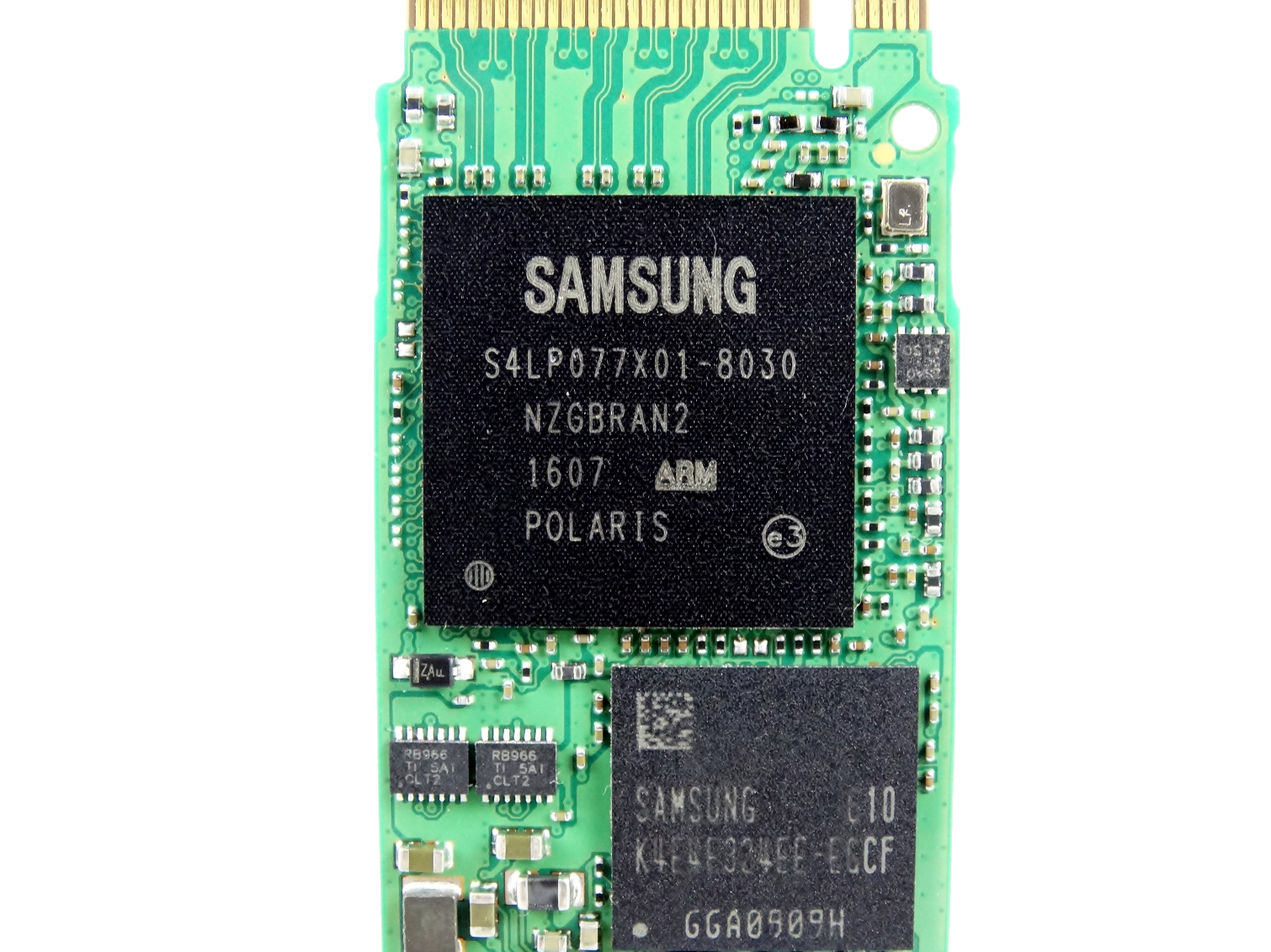Early Verdict
If a vendor offered the PM961 in a factory notebook, we wouldn't turn it down. The drive offers higher performance than any of the SATA options. The price is simply too high for the upgrade market, and the accessory package, along with a solid warranty, are nonexistent from resellers. The PM961 is simply a precursor to a retail product that we feel will hit store shelves in the next 30 days.
Pros
- +
Mainstream performance with TLC
- +
Low cost after the NAND shortage subsides
- +
Solid OEM upgrade for a factory-built notebook
Cons
- -
OEM only
- -
High cost
- -
Mainstream performance
- -
Limited availability
Why you can trust Tom's Hardware
Specifications & Features
Everyone in the inner circle of the SSD world is buzzing about the successor to Samsung's 950 Pro NVMe. We already tested the Samsung SM961 several times in the past, and it should be representative of the new 960 Pro. The low-cost EVO variant is even more exciting because it features the same Samsung Polaris controller and DRAM as the SM961 but uses 48-layer 3-bit per cell (TLC) flash. We're testing the PM961, which is the TLC version of the SM961, and likely the close cousin to the 960 EVO that will possibly launch in the next month.
Since its inception, the EVO series has dominated retail sales. Samsung actively monitors the price of competing products and maneuvers the EVO models appropriately, so the EVO products often cost a little more compared to entry-level and mainstream products. The strategy only works because the EVO series typically delivers significant improvements over competing products.
The improvements are not just performance-based, although it plays a key role. Samsung delivers an all-round package with higher performance, best-in-class software packages, high availability (products sold in local retail stores) and excellent reliability. It's difficult for non-fab SSD manufacturers to compete with Samsung's all-bases-full strategy. Even fab competitors (those that make NAND flash) that aren't fully vertically integrated (the ability to make controllers, DRAM and NAND flash) have a hard time competing with Samsung.
Samsung's big advantage isn't just its crafty strategy, accessories or price; it's the flash. Samsung was the first to release retail products with 3D NAND, and its dual plane design maximizes parallel operations to the controller. Until the PM961, we didn't know how fast Samsung's TLC V-NAND really was because the SATA ceiling limited most of its products. The PM961 will finally give us a chance to see if Samsung's 3D NAND has a lead over IMFT's (Intel/Micron) new 384Gbit TLC 3D NAND.
Technical Specifications
| Product | Samsung PM961 |
|---|---|
| Pricing | Unknown |
| Controller | Samsung Polaris |
| Protocol | NVMe |
| Form Factor | PCIe 3.0 x4 M.2 Single-Sided 2280 |
| NAND | Samsung 48-Layer TLC V-NAND |
| DRAM | Samsung LPDDR3 |
| Available Capacity Sizes | 128GB, 256GB, 512GB, 1TB |
| Sequential Read | Up To 3,000 MB/s |
| Sequential Write | Up To 1,150 MB/s |
| Random Read | Up To 360,000 IOPS |
| Random Write | Up To 280,000 IOPS |
| Endurance | Unknown |
| Warranty | Varies By Seller |
We still don't know a lot about the Polaris controller, other than the fact that Samsung uses it in the fastest consumer NVMe SSD ever made (the SM961). The PM961 uses the same controller and low-power DDR3 DRAM as the SM961, but Samsung changed the flash from 2-bit MLC to 3-bit per cell (TLC) V-NAND. Samsung's 3rd generation V-NAND is somewhat special and comes with a 48-layer 256Gbit die. Samsung designed the flash to reduce manufacturing costs by ramping up the capacity within roughly the same wafer footprint. Samsung's 48-layer NAND has been successful, but the company already announced the technical details of its 60-layer successor. Samsung's next generation NAND provides 512Gbit of capacity per die, but we don't expect products with the new V-NAND to ship until 2017.
Just because we know about the next generation doesn't mean we should overlook the importance of the current 48-layer flash. Only a few retail products have shipped with the 48-layer 256Gbit die. Samsung launched the Portable SSD T3 this year, retooled the higher capacity 850 EVO SSDs, and slowly trickled out the SM961 with the new flash. The PM961 is only the fourth product we've tested with 48-layer V-NAND.
The only PM961 performance specifications we have come from a Samsung event held earlier this year in Japan. The specifications in the chart come from a place card pictured at the event, and we don't have specifications for individual capacities or endurance. We do have the PM961 512GB, which will give us a taste of what Samsung has on the grill.
Get Tom's Hardware's best news and in-depth reviews, straight to your inbox.
Samsung used new multi-manager test methods to achieve the high performance values cited in its specifications. We still use industry-standard testing that is more representative of normal user workloads, so you shouldn't expect to see 3,000 MB/s in our tests. We used multi-manager test methods only to validate Samsung's claims, and we actually achieved slightly better performance. The PM961 is impressive with 3,000 / 1,500 MB/s of sequential read/write speed. The random read performance surpasses 360,000 IOPS, and random writes are not far behind with 280,000 IOPS. On paper, the PM961 appears to give the 950 Pro with 32-layer MLC V-NAND a run, but in practice, the additional TLC latency hinders performance. Still, this high-performance product will eventually make an excellent mainstream NVMe SSD for shoppers looking to break free from the bonds of SATA. It will come at a friendlier price point, too.
The PM961 also supports several advanced features. The drive can operate in L1.2 low power states and employs TurboWrite technology, which is an SLC-mode buffer that absorbs random writes to increase performance and reduce flash wear. The PM961 does not support some features that we expect from the retail model, such as Rapid Mode and full-disk AES hardware encryption.
Pricing, Warranty And Accessories
Securing a PM961 isn't easy, but you can find them for $549 with a lead-time of 1 to 2 months. We paid $313 for a PM961 512GB to make this 960 EVO preview possible. Our drive took just over a week to arrive, and there isn't a warranty to speak of, though we did get an M.2 screw with the drive as a consolation prize. Some notebooks do not include the M.2 screw, particularly if you order the system without an M.2 SSD.
We don't recommend buying a PM961 because the price is very high due to the limited availability. The OEM products also do not work with Samsung's Magician Software. This isn't much of an issue, but with the 960 Series so close to launch, we would wait another month and compare the OEM SSDs to the retail products. The retail versions, which will presumably come to market bearing 960 Pro and 960 EVO branding, will work with Magician. The 960 EVO may include access to Rapid Mode, which is a system-level RAM buffer that increases performance and reduces NAND flash wear. Samsung's retail SSDs also work with the company's disk cloning software. The big takeaway is the Rapid Mode software and easy access to Samsung's NVMe driver, which we will cover later in the review.
A Closer Look
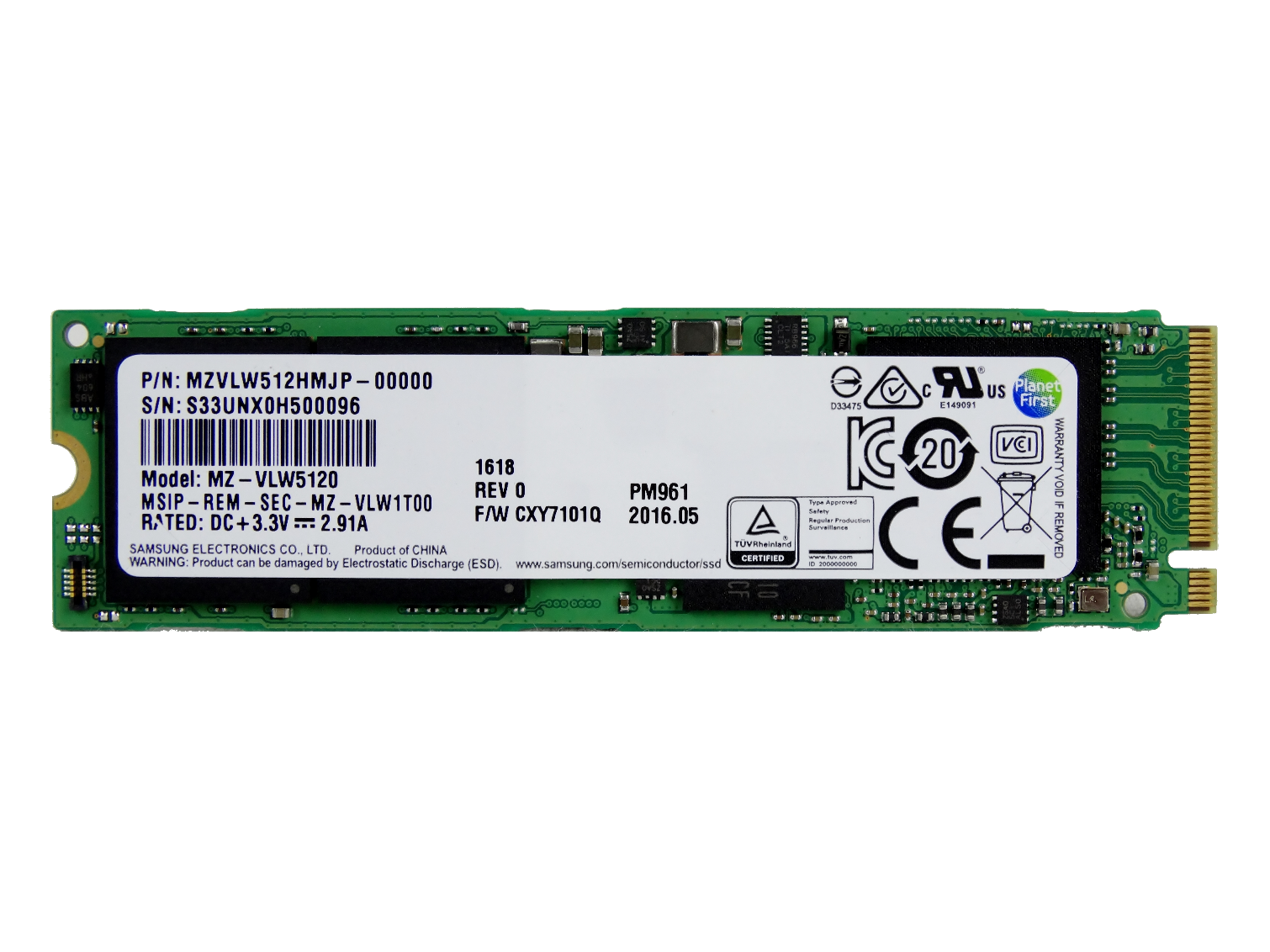
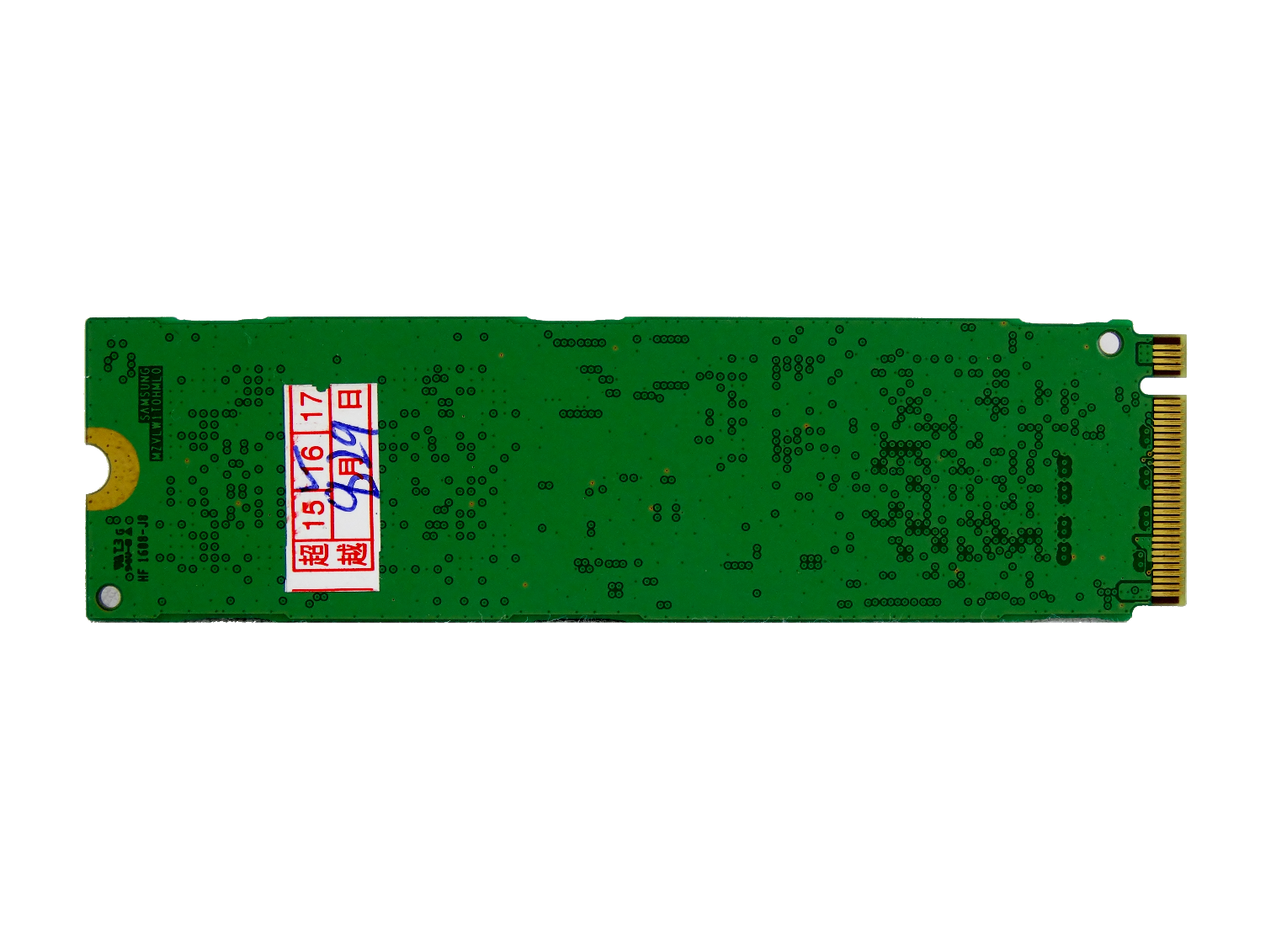
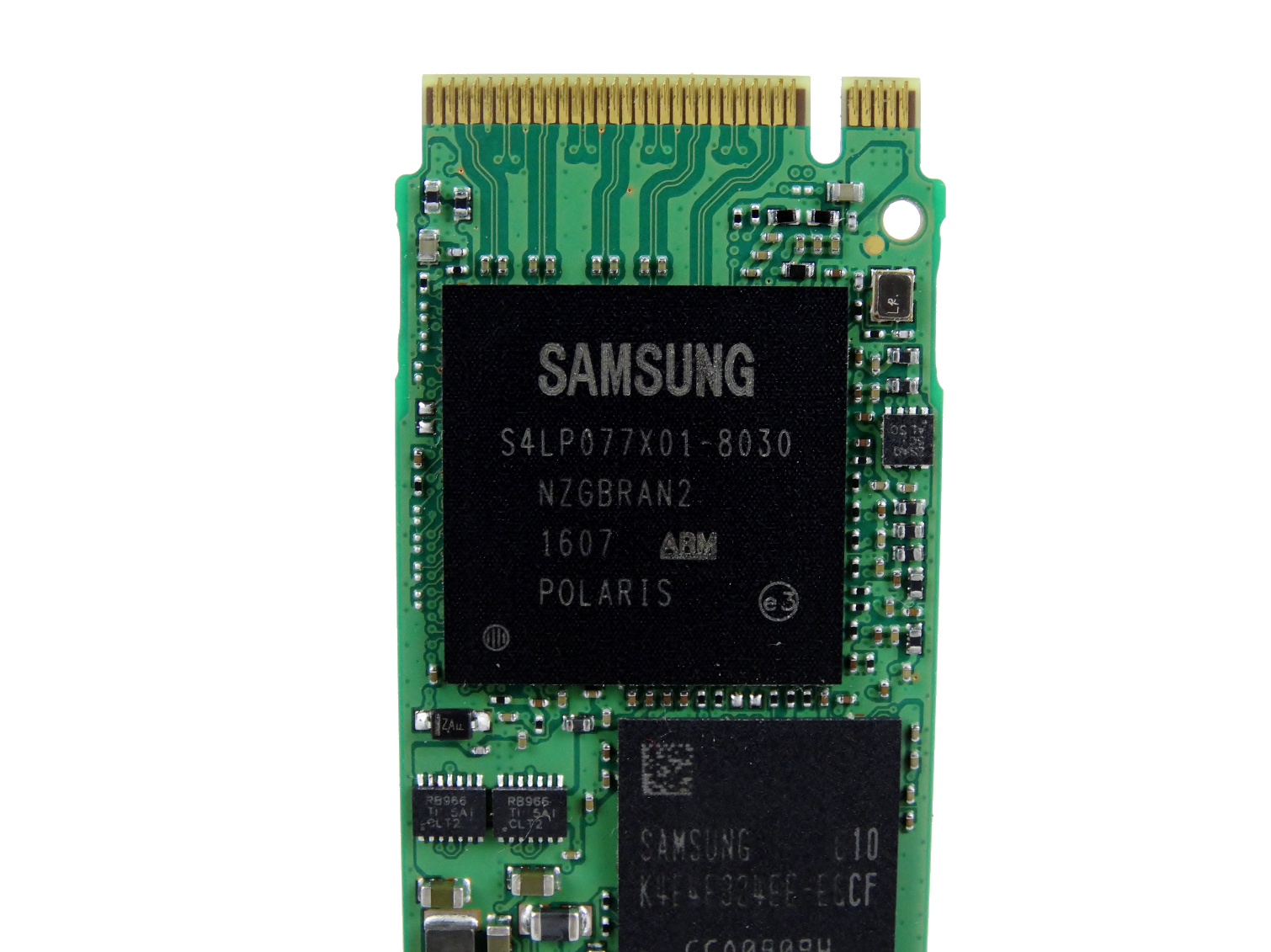
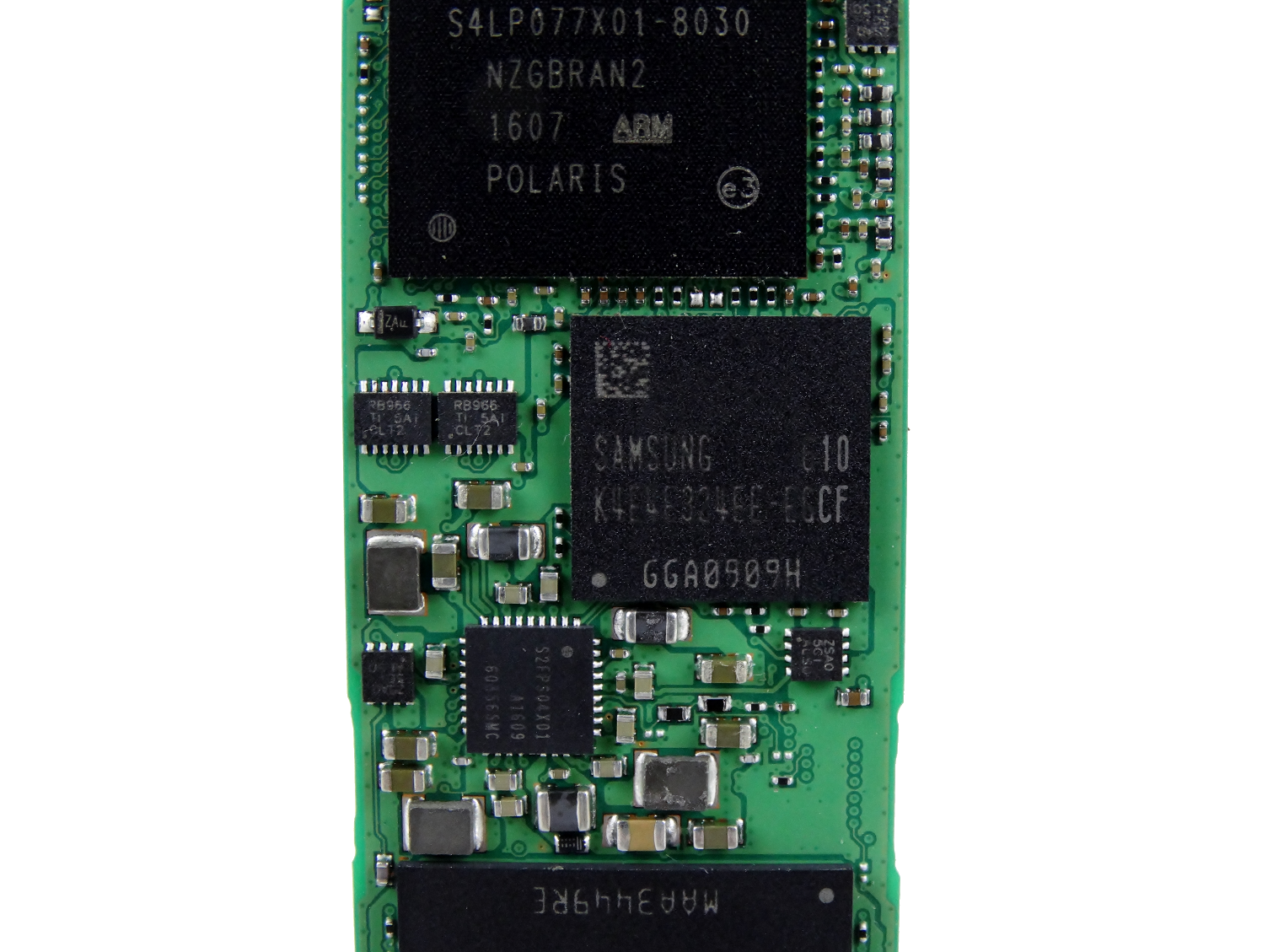
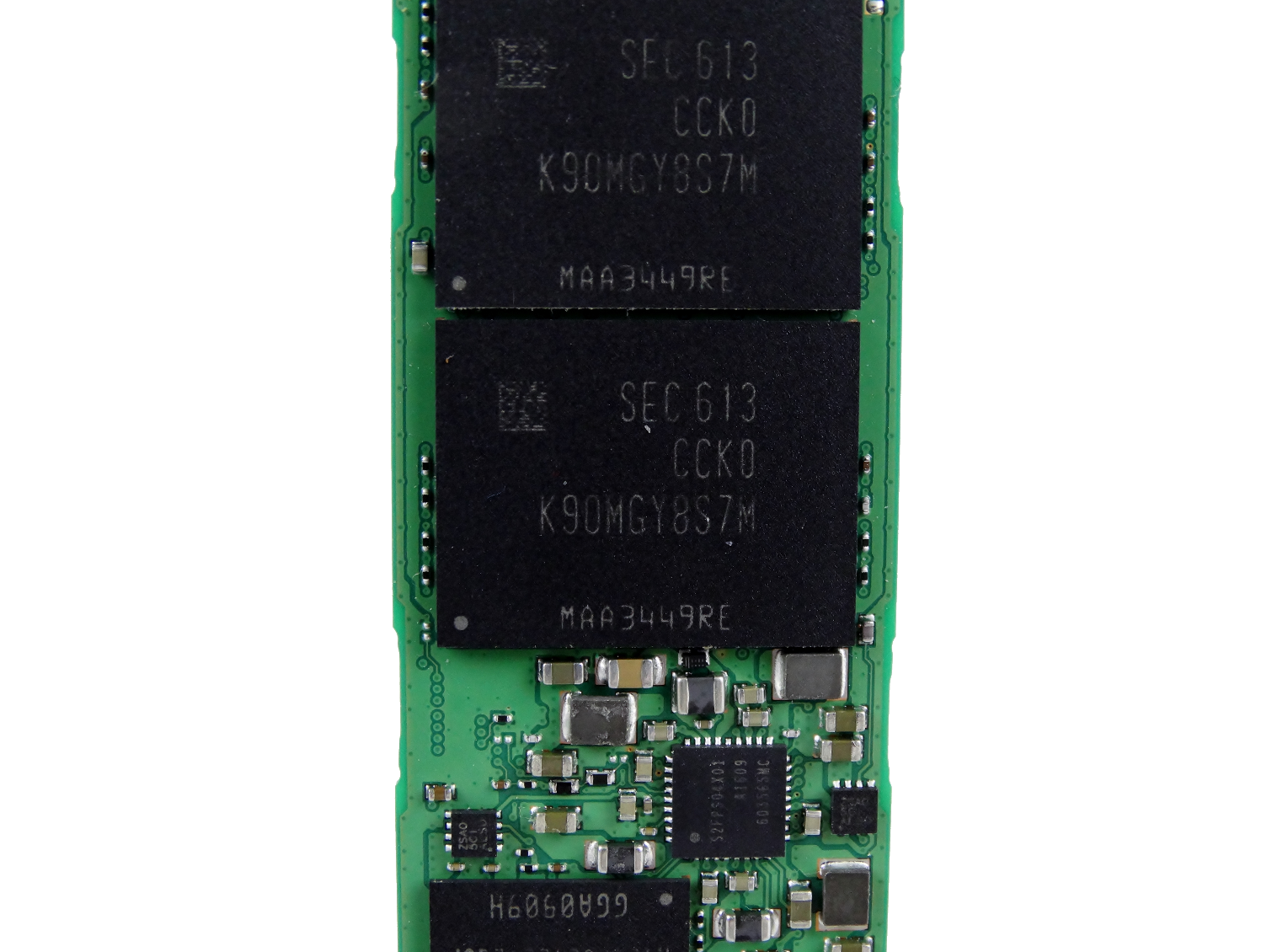
The drive doesn't offer us a lot of insight into the new PM961, or its potential 960 EVO retail counterpart. The SSD appears to be identical to the SM961 that we already tested, and it features the same controller and DRAM. The Polaris controller is at the heart of the SSD and Samsung LPDDR3 backs it up. Two packages of Samsung 48-layer TLC flash round out the major components, and each package contains eight 256Gbit (32GB) die stacked on top of one another.
The PM961 uses a single-sided design to increase compatibility with OEM designs. The single-sided design features all of the surface mount components on one side of the printed circuit board, which allows OEMs to place the drive closer to the motherboard, and thus design slimmer products. Eventually, many of the slim products will get a storage upgrade, but the dual-sided products will not work in some of them. We've already seen a Lenovo Carbon X1 with the issue. The Lenovo motherboard has another chip package under the M.2 area, so it is impossible to install a dual-sided M.2 SSD and reassemble the case.
MORE: Best SSDs
MORE: Latest Storage News
MORE: Storage in the Forums

Chris Ramseyer was a senior contributing editor for Tom's Hardware. He tested and reviewed consumer storage.
-
David_446 I actually own both the SM961, 1TB srive and a PM961, 1TB drive. A friend of mine has access to them, he isn't an enthusiast but i am. I paid $580 and $490 respectively. A little expensive but I got them before most. I am running with the Samsung driver force installed and I have to admit, they BOTH fly. The temps rise only when running benchmarks, which I only ran once. My games take les than 10 seconds to load, FAST. File transfers ZIP!!! I did start out with the Windows driver but switched very soon after as my write speeds were very slow.Reply -
littleleo So this is for a Product that has not come out and may come out this month or next month and doesn't exist right now. So you are using a existing OEM model and testing it and thinking it is close to what we should expect for the 960 Evo? I think it must be really slow there if you are doing these pseudo test in articles for a not released products. Seems like something I wouldn't expect from a Tom's.Reply -
philipemaciel It would be nice to add SATA SSDs to this kind of comparison. For most of the readers, I believe, it would be useful to decide if it is worth the move away from SATA — which most of us are using anyway.Reply -
David_446 Well, I own both drives and appreciate the information. I acknowledge the article was in speculation of what to expect from a potential product. Much the same way the SM951 was for the 950pro. Both excellent performers. I was considering selling one of my drives to a friend, but after reading this, I think the prices I paid was reasonable for a component that is so hard to find and performs exceptionally well. If this is an indication of what you do in your "slow period" I for one am grateful. Any information is useful if you know how to use it. Thank youReply -
tripleX Most people probably don't recognize what investigative journalism is because it is so rare in the age of the Internets. The Samsung OEM SSDs have been the same as the retail SSDs for several generations now, so it isn't exactly rocket science to know this is the next one to come out.Reply
Good show, Toms. -
CRamseyer Reply18586179 said:It would be nice to add SATA SSDs to this kind of comparison. For most of the readers, I believe, it would be useful to decide if it is worth the move away from SATA — which most of us are using anyway.
With low-cost NVMe we will mix some SATA in the charts but for this review we wanted to go all NVMe. It's the lead for this category and shows where the new NVMe stands in relation to existing NVMe.
-
Game256 It's pretty strange that OEM-parts are selling all over the Europe but not presented at the biggest consumer market which is USA.Reply
As for comparison of OEM and retail versions - yes, basically they're very close but I wouldnt' say they're the same. For example, Samsung SM951 256 Gb is significantly better than it's retail version Samsung 950 Pro 256 Gb. -
HERETIC-1 Chris,why do you think Sammy goes with such a small SLC buffer?Reply
Regularly read how Sammy is so far ahead of I/M,yet best I can
tell Sammy 3D is on 40nm and I/M is on 20nm-We know the downsides
that a smaller process brings,but the die to wafer benefits are huge........... -
jt_AJ1 @LITTLELEOReply
wow seriously? do you honestly think these OEM drives are so far apart from retail product when they come out? makes me laugh when I see people think of ES are a lot worse than actual QS CPU chips.
PM961 is as good as it gets, fanboi
as always, great review! -
littleleo Reply18588152 said:@LITTLELEO
wow seriously? do you honestly think these OEM drives are so far apart from retail product when they come out? makes me laugh when I see people think of ES are a lot worse than actual QS CPU chips.
PM961 is as good as it gets, fanboi
as always, great review!
Actually I sell the OEM versions too, and in some cases the performance and the Warranty is the same. What I'm saying is the article was a Samsung 960 EVO preview, but it was actually about the PM961. So just eval it as the PM961 with the info you expect the 960 EVO to have similar specs if you want to. I just feel this is a bit of a bait and switch article. I agree the specs are similar but, why not wait and eval the actual 960 EVO when released since it isn't that far to go. Most likely you will review it anyway, so this article will be rehashed.
It's like going to see a new model car in a showroom and the guy tells you that model isn't in yet but this other model is so close to it and we can add the same features so it will be the same, right? It is a little bit of a let down.
